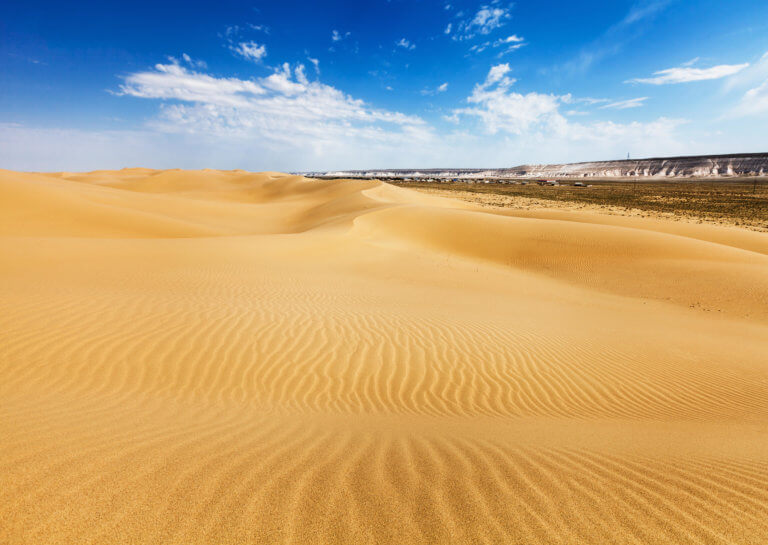
Shakpak-Ata
Tucked away inland of Sarytash Bay is the 10th-century Shakpak Ata, one of Mangystau’s most well-known historical-religious sites. Tauchik, a small village, is the nearest
Sherkala (332m) is 5km west of Ayrakty-Shomanai on the northern side of the West Karatau Range. Its name is derived from the Persian words for lion (shir) and fortress (qalat), as its western aspect resembles a resting lion. Its southern aspect looks like a yurt and features on Kazakhstan’s 1,000 tenge banknote.
Surrounding Sherkala’s outer perimeter are rocky pillars, craggy faces and dozens of former watercourses turned into chalky canyons up to 100m deep. If you want to reach the top, it’s possible to climb or scramble your way to the summit or, if you can find it, there’s a supposed secret passage with rope ladders leading to the top.
Spend a full day at Sherkala and you’ll witness the stunning transformation of its white limestone cliffs as they shift in colour with the changing light – from glistening in the sun and glowing in the moonlight, to a fiery display of red and orange hues at sunset.With a couple of hours to spare, it’s possible to walk around its 3-kilometre-long perimeter and delve into its many caves. Legend has it that completing a full loop makes your wishes come true. Keep a lookout for horse and camel herds.
In the early 12th century, Arab Shah Atsiz of Khwarezm invaded the Mangystau Region and created the nearby ‘Mankashlak’ settlement. Remnants of the region’s past can be seen at Shikh Ata Necropolis and the small 18th–20th century Temir Abdal Mosque, carved into the cliffs overlooking Shikh Ata.
There’s also the 10th–13th century Kyzylkala settlement next to Akmysh spring, featuring the remains of several hundred building foundations. For a closer look at its layout, check out Mangystau’s Department of Culture 3D model and 360-degree video of Kyzylkala.
Sherkala, along with its neighbouring settlements, played a vital role as a caravanserai during the Silk Road era. It served as a key stopover for traders journeying from regions as distant as Iraq, often with large caravans, heading towards the northern territories, including parts of what is now Russia.
Reaching Sherkala requires a nearly 3-hour drive from Aktau. You need a decent off-road vehicle once you turn off the main Atyrau–Aktau road. Four kilometres south of Sherkala is Samal Gorge, which, unusually, has a freshwater spring flowing year-round.
Sherkala (Şerqala/Шеркала): 44.2561, 52.0056
Samal Gorge (Samal Şatqaly/Ущелье Самал): 44.2155, 51.9921
Shikh Ata Necropolis (Şih Ata/Ших Aта) and Temir Abdal Mosque (Temır Abdal Meşıtı/Мечеть Темир Абдал): 44.2563, 51.9932
Kyzylkala (Qyzylqala/Кызылкала): 44.2467, 51.9871
1:200k Soviet map of Sherkala, shown on the upper edge of the bottom-left quarter marked “307”.
An illustrated overview of some of Mangystau’s underground mosques by the region’s Department of Culture.
Nissan March Karakum’s video exploring the cliffs and caves of Sherkala.
Photos and historical overview of Kyzylkala.

Tucked away inland of Sarytash Bay is the 10th-century Shakpak Ata, one of Mangystau’s most well-known historical-religious sites. Tauchik, a small village, is the nearest

Senek Sands, also known as Tuyesu Sands, is an 11 x 30km area of dunes located halfway between Zhanaozen city and Boszhira. Barchan dunes cover

Kapamsay Canyon is a few kilometres south-west of Shakpak Ata. When approaching it from afar, you’ll see the white-sided walls of the chasm peeking up
Copyright © Planet Esoterica, 2024. No part of this site, www.planetesoterica.com, may be reproduced in whole or in part in any manner without the permission of the copyright owner. All rights reserved.
Made with 